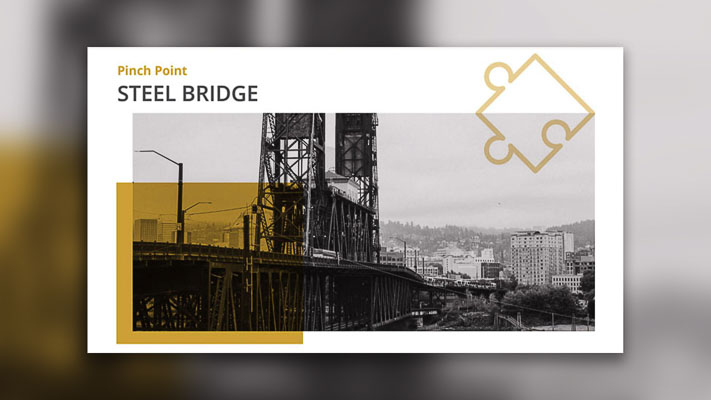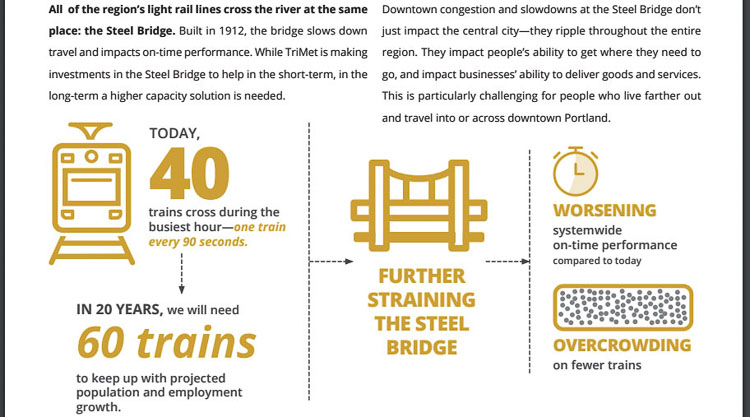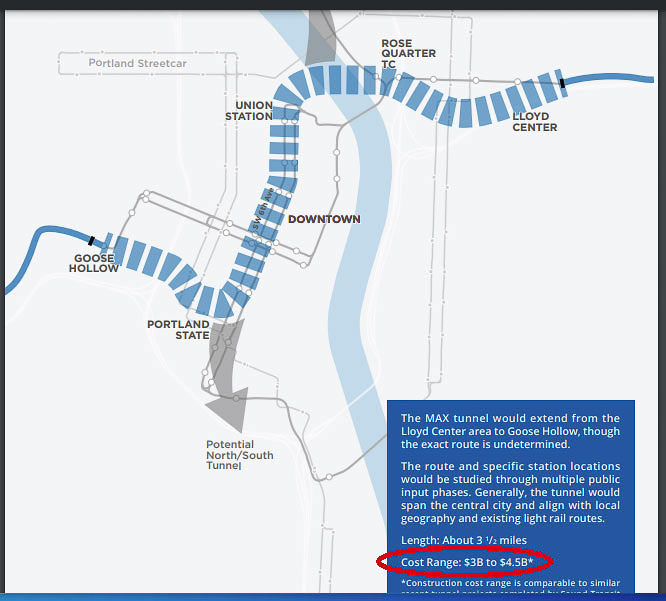
IBR administrator says demand for transit across the Columbia River will increase 10 fold
At the April 7 meeting of the Interstate Bridge Replacement (IBR) program’s Executive Steering Group (ESG), Administrator Greg Johnson answered a question previously asked by Sen. Lynda Wilson (Republican, 17th District). “What does substantial demand look like” for high capacity transit,’’ Wilson asked on March 23.
Johnson’s answer last week – 26,000 to 33,000 riders a day using the Interstate 5 corridor and replacement bridge.
“What does that mean,” Wilson wanted to know. She asked to see the information (data) that backs up the statements. She pointed out the 50 percent decline in transit ridership due to the pandemic. “It’s being underutilized,” she said.
Wilson asked if people were merely expressing “interest,” or if they were dedicating themselves to riding the new transit if it was built. She also wanted details on how they could project ridership out to 2045.
IBR Administrator Greg Johnson tells the members of the Executive Steering Group that substantial demand for transit on the replacement Interstate Bridge means 26,000 to 33,000 riders a day. That is a 10-fold increase over what his team reports is using transit across the bridge today. Video courtesy IBR
Current transit ridership
In 2019, before the pandemic lockdowns devastated transit ridership both locally and nationally, C-TRAN had 5.9 million annual boardings. That would equate to 16,410 boardings per day, or about 8,205 people who rode a bus both ways to and from work, etc. on the entire C-TRAN system.
Looking at it another way, C-TRAN has 122 buses. This would indicate each bus had 134.5 boardings per day, serving 67 people making round-trip travel. C-TRAN financial records report they carried 21.6 passengers per in-service hour in 2019.
C-TRAN offers the only transit service across the Columbia River, as there hasn’t been enough demand for TriMet to offer service as well. C-TRAN’s ridership to Portland peaked in 2016 and has been in decline ever since.
Average weekday ridership on C-TRAN express routes to Portland:
2016 – 3,040
2017 – 2,874
2018 – 2,844
2019 – 2,892
2020 – 971
C-TRAN experienced a 61 percent drop in passenger boardings on the express bus system over the past two years. The agency shared numbers for nine separate routes traveling over the river for the past three years. In 2019, it had 1.4 million boardings which then declined to 555,000 last year.
For Portland’s TriMet, the Yellow Line MAX had 13,430 boarding rides in the fall of 2019. That dropped to 5,290 a year later, a 61 percent decline. If people traveled round trip, they served 6,715 people a day before the pandemic. TriMet has said they don’t expect its ridership to return to pre pandemic levels for six years.
Going from 3,000 C-TRAN cross river boardings to just under 1,000 boardings and then increasing to 26,000 or 33,000 boardings is significant, if that demand actually materializes.
At last week’s ESG meeting, Johnson told the 12 members he had been asked for details relating to there being “significant demand” for transit on a replacement Interstate Bridge. There are currently 3,400 transit trips using the Interstate Bridge according to the IBR, he reported, with 1,700 using the C-TRAN express bus service.
“With our modeling efforts showing high capacity transit crossing the bridge, both numbers now jump up to 26,000 to 33,000 average weekday trips projected on high capacity transit,” Johnson stated. “That is substantial; 10 times more folks using transit than (are) using it currently.” He further elaborated “we did not pull these numbers out of the sky.”
Clark County Today has asked for details relating to who created those numbers and where they expect the ridership demand to come from. None have been provided.
Is it even possible to handle 26,000 to 33,000 weekday transit trips across any new bridge? TriMet has a history of broken promises related to their new MAX light rail lines. Will this be any different if light rail is chosen by Johnson’s team?

The two forms of high capacity transit under consideration are an extension of TriMet’s Yellow Line MAX light rail or C-TRAN’s Bus Rapid Transit (BRT). It is logical to assume the majority of increased transit service “demand” would be during rush hour, roughly three hours in the morning going into Portland and three hours in the evening returning across the bridge.
How many can MAX serve?
The majority of MAX light rail cars can carry 64 passengers seated and another 102 passengers standing per car. Because of the short length of a downtown Portland block, TriMet can only put two cars on a MAX train. Each train can carry 332 people, with only 38 percent seated. Those Yellow Line trains travel about 14 mph on their journey to downtown Portland.
The maximum TriMet light rail service presently offered is 15-minute headways, or four trains every hour. This would indicate 1,328 people could be served each hour, or about 4,000 during a rush hour commute. If TriMet were to double service, a promise it has made in the past and failed to actually deliver, it could offer crowded light rail service for about 8,000 people.
But there are obstacles for TriMet attempting to double MAX service to 7.5-minute headways on the Yellow Line. Presently during rush hour, TriMet reports there is one MAX train crossing Portland’s 110-year-old Steel Bridge over the Willamette River every 90 seconds. There is minimal room for adding service. MAX currently runs “on time” only 88 percent of the day.
Furthermore, assuming ridership returns to pre pandemic levels at some point, TriMet would have to add even more capacity. If Vancouver and Clark County residents fill up existing MAX trains, what will north Portland riders do? How many Oregon riders would use transit from Hayden Island, Delta Park, and Lombard Street stations if light rail trains are already full? TriMet would have to add more trains or put their north Portland customers on buses.

At some unknown date in the future, TriMet officials hope to persuade the citizens of the Portland metro area to spend up to $4.5 billion to build a new tunnel under the Willamette River exclusively for light rail. It reports 40 trains an hour now during rush hour, and expects 60 an hour in 20 years.
TriMet officials say they can’t accommodate that 50-percent increase without a new tunnel. It would allow TriMet to schedule current light rail trains at 10-minute headways. That would only allow a Yellow Line extension from Vancouver to serve an additional 600 passengers an hour, with over 60 percent of those people standing.
“The bridge slows down travel and impacts on time performance,” TriMet says about the Steel Bridge. They call it a “pinch point”.
“Downtown congestion and slowdowns at the Steel Bridge don’t just impact the central city–they ripple throughout the entire region,” TriMet says. “This is particularly challenging for people who live farther out and travel into or across downtown Portland.”
Presently there are 13,000 boardings (pre pandemic) of mostly Portlander’s heading north and south. Light rail capacity would have to be increased to handle at least 40,000 boardings a day on the Yellow Line if the IBR projections were accurate. Otherwise, those Portlanders would have to be offered buses or get in their cars.
To accommodate 20,000 people (two way travel), most traveling during work hours, MAX would need four to five times the 2-car MAX train capacity running at 7.5-minute headways. Or it would need the ability to have 8-car MAX trains, an impossibility given the current system of running trains on city streets.
Can BRT handle the increase?
C-TRAN offers the only bus rapid transit service in the region, but TriMet officials hope to offer new BRT service soon on a single route along Division Street. The Vine began service five years ago, using double-articulated buses that can carry 100 passengers, 60 seated and 40 standing.
Looking at simple vehicle capacity, you would need three BRT buses (300 people) to equal one 2-car MAX train (330-340 people).
In order to equal the hourly capability of a 2-car MAX light rail train, (1,300 people an hour presently), 13 BRT buses would be needed an hour. That would be about one BRT bus every four and a half minutes. But those buses could start from several origins, i.e. one or two from Salmon Creek, one from Kiggins Bowl, one from Hazel Dell, and perhaps one or two from the Turtle Place Transit center. If there were demand from East Clark County, it could add service from the Vancouver Mall and their new Mill Plain BRT systems.
At five-minute headways, one BRT line could handle 3,600 people during a three-hour commute period. With 26,000 to 33,000 boardings, that is 13,000 to 16,500 people traveling both ways. If one were to assume the majority of people were willing to travel on high capacity transit during the three-hour morning and evening commute, it would take about eight separate BRT lines running at five-minute headways.
The flexibility of BRT to serve different communities far exceeds the ability of light rail, which is limited by where you put the tracks down, and the “pinch point” of the Steel Bridge.

“Once you lay down the tracks, that’s permanent,” Wilson said last month. She expressed concerns about people being forced to live along the light rail corridor to access that form of transit. Whereas the BRT and even the express bus service is very flexible, she noted.
A C-TRAN BRT bus carries 100 passengers. To accommodate the 13,000 to 16,500 people presumably traveling two ways, 130 to 165 BRT buses would be needed for the three-hour commute period. Cut those numbers in half as each BRT bus could easily make two round trips during a 3-hour commute period.
Transportation architect Kevin Peterson has pointed out that one vehicle lane can handle about 1,800 vehicles an hour. If that’s the case, it would seem all those BRT double-articulated buses could easily travel in a vehicle lane, alongside cars and trucks and freight. They would only occupy at most 10 percent of the vehicle capacity one lane provides. Why not allow other vehicles to use that lane when buses are not present?
Johnson has promised his team will be “data driven.” The data shows that light rail cannot accommodate anywhere close to the 26,000 to 33,000 daily trips on MAX his team is projecting.
At current service levels, the Yellow Line could only handle about 4,000 people during a three-hour commute period. Where will the other 9,000 to 12,000 people go? Will they choose to drive their cars? Or will they choose the other “multi-modal” option the IBR is offering, walking or biking?
BRT buses allow 60 percent of passengers to be seated. That is just the opposite of light rail trains. The MAX Yellow Line travels an average of 14 mph, slower than BRT buses. Which mode of transit would people prefer?
The IBR team apparently believes demand for transit across the Columbia River could increase 10 fold in the not too distant future. Do they believe the people want to stand while traveling in slower light rail vehicles? Clark County residents have said multiple times they do not want light rail.












